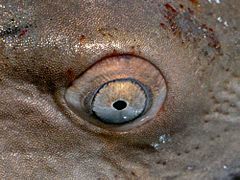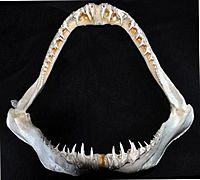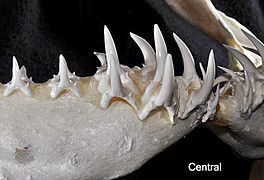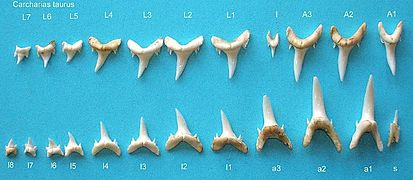Sand tiger shark facts for kids
Quick facts for kids Sand tiger shark |
|
|---|---|
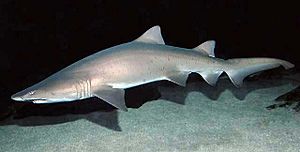 |
|
| Conservation status | |
| Scientific classification | |
| Genus: |
Carcharias
|
| Species: |
taurus
|
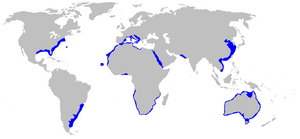 |
|
| Range of the sand tiger shark | |
| Synonyms | |
|
Carcharias tricuspidatus Day, 1878 |
|
The sand tiger shark (Carcharias taurus) is a type of shark found in warm and mild waters all over the world. It's also known as the grey nurse shark or spotted ragged-tooth shark. These sharks live near sandy coastlines and underwater reefs, from shallow areas down to about 190 meters deep. You can find them in places like Japan, Australia, South Africa, the Mediterranean, and along the east coasts of North and South America. Even though its name sounds like "tiger shark" or "nurse shark," it's not closely related to them.
Despite looking a bit scary with its sharp teeth, the sand tiger shark is usually calm and moves slowly. There are no confirmed cases of this shark causing human deaths. This shark has a pointy head and a big, strong body. Sand tiger sharks can grow up to 3.2 meters long. They are grey with reddish-brown spots on their backs. Sometimes, groups of these sharks hunt large schools of fish together. They eat bony fish, crabs and lobsters, squid, skates, and other sharks. Unlike most sharks, the sand tiger can swallow air from the surface. This helps it float in the water without much effort. When a female sand tiger shark is pregnant, the strongest baby shark will eat its smaller siblings. This is a natural way for them to ensure the strongest survive. The sand tiger shark is listed as "vulnerable" by the International Union for Conservation of Nature. It's a popular shark in public aquariums because it handles being in captivity well.
Contents
What is a Sand Tiger Shark?
The sand tiger shark was first described as Carcharias taurus by Constantine Rafinesque in 1810. He saw a shark caught off the coast of Sicily. The name Carcharias taurus means "bull shark." Over the years, scientists have debated what to call this shark. Its name changed a few times, but eventually, the International Code of Zoological Nomenclature (ICZN) approved its current scientific name, Carcharias taurus. This is the name most biologists use today.
Different Names for the Sand Tiger Shark
Since the sand tiger shark lives all over the world, it has many different names.
- The name "sand tiger shark" can sometimes be confusing because it sounds like the unrelated tiger shark (Galeocerdo cuvier).
- In Australia and the United Kingdom, it's often called the grey nurse shark.
- In India, it's known as the blue-nurse sand tiger.
- Perhaps the clearest name is the one used in South Africa: the spotted ragged-tooth shark.
How to Identify a Sand Tiger Shark
There are actually four species that are sometimes called sand tiger sharks. The main one is Carcharias taurus. The others are:
- The Indian sand tiger shark (Carcharias tricuspidatus).
- The small-toothed sand tiger shark (Odontaspis ferox). This one lives in deeper water.
- The Big-eyed sand tiger shark (Odontaspis noronhai), a deep-water shark from the Americas.
It can be tricky to tell the sand tiger shark apart from the two Odontaspis species. Here are some clues:
- The sand tiger shark usually has spots, especially on the back half of its body.
- The bottom part of the sand tiger's tail fin is smaller.
- The sand tiger's second dorsal fin (the one closer to the tail) is almost as big as its first dorsal fin.
- The sand tiger's first dorsal fin is not perfectly even on both sides.
- The sand tiger's first dorsal fin is closer to its pelvic fin (belly fin) than to its pectoral fin (side fin). This means the first dorsal fin is set further back on its body.
Description of the Sand Tiger Shark
Adult sand tiger sharks are typically 2 to 3.2 meters long and weigh between 91 and 159 kilograms. Their head is pointy, not round, and their snout is flat and cone-shaped. They have a strong, bulky body, and their mouth extends past their eyes. Sand tiger sharks have small eyes and no eyelids. They often swim with their mouths open, showing three rows of sharp, smooth teeth that stick out. Male sand tigers have grey claspers with white tips on their underside. Their tail fin is long with a larger upper part. They have two large, wide grey dorsal fins located behind their pectoral fins. The sand tiger shark has a grey-brown back and a lighter underside. Adult sharks usually have reddish-brown spots, mostly on the back part of their body. In 2007, an albino (all-white) sand tiger shark was seen off South West Rocks, Australia. Their teeth are smooth, with one large main point and a tiny point on each side. Small teeth separate the front upper teeth from the side teeth.
Habitat and Where They Live
Geographical Range
Sand tiger sharks live in the upper and middle layers of the ocean, sandy coastal waters, river mouths (estuaries), shallow bays, and rocky or tropical reefs. They can be found at depths of up to 190 meters.
You can find sand tiger sharks in the Atlantic, Pacific, and Indian Oceans, as well as in the Mediterranean and Adriatic Seas. In the Western Atlantic Ocean, they live in coastal waters from the Gulf of Maine down to Florida, in the northern Gulf of Mexico, around the Bahamas and Bermuda, and from southern Brazil to northern Argentina. In the eastern Atlantic, they are found from the Mediterranean Sea to the Canary Islands, near the Cape Verde islands, along the coasts of Senegal and Ghana, and from southern Nigeria to Cameroon. In the western Indian Ocean, they range from South Africa to southern Mozambique. They have also been seen in the Red Sea and possibly as far east as India. In the western Pacific, they are found in the waters around Japan and Australia.
Annual Migration
Sand tiger sharks in South Africa and Australia travel long distances each year, sometimes over 1000 kilometers. They give birth in the summer in cooler waters (around 16°C). After giving birth, they swim north to places with suitable rocks or caves, often about 20 meters deep, where they mate during and after winter. Mating usually happens at night. After mating, they swim even further north to warmer waters where the babies grow inside the mother. In the autumn, they return south to give birth in cooler water. This whole trip can be as long as 3000 kilometers! Young sharks don't join this migration. They are not found in the birth areas during winter, so scientists think they move into deeper parts of the ocean.
Behavior of Sand Tiger Sharks
Hunting and Diet
The sand tiger shark hunts mostly at night. During the day, they hide near rocks, overhangs, caves, and reefs, often in shallow water (less than 20 meters). This is where divers usually see them, hovering quietly near the bottom. At night, they leave their shelters and hunt over the ocean floor, often traveling far. Sand tigers hunt by surprise. They are the only sharks known to gulp air and store it in their stomach. This helps them float without much effort, allowing them to hunt silently and without moving much. Observations in aquariums show that when a sand tiger shark gets close to its prey, it quickly snaps sideways to grab it. Groups of sand tiger sharks have been seen hunting large schools of fish together.
Most of what sand tigers eat comes from the sea bottom, which suggests they hunt a lot on the ocean floor. About 60% of their food is bony fish, and the rest includes other sharks and skates. Smaller sand tigers mostly eat prey from the sea bottom. As they grow larger, they start eating more free-swimming prey. This shows that sand tiger sharks are opportunistic feeders, meaning they eat whatever is available.
Courtship and Mating
Sand tiger sharks mate around August to December in the northern half of the world, and during August to October in the southern half. Scientists have learned a lot about their mating by watching them in large aquariums. When a female is ready to mate, she might hover just above the sandy bottom. This helps her avoid males approaching from below. Often, several males are nearby, but one dominant male stays close to the female. He might scare off other males by following their tails closely until they swim away. The dominant male might also snap at smaller fish of other species.
The male approaches the female, and they both protect the sandy area where they are interacting. If the male is very interested, he might gently bite the female's anal and pectoral fin areas. The female might also gently bite the male. This can go on for several days, with the male patrolling around the female. The male regularly "noses" the female's cloaca (a body opening) to check if she is ready. If she is, they swim off together, twisting their bodies so the male's right clasper enters the female's cloaca. The male bites the base of her right pectoral fin, leaving scars that can be seen later. After a minute or two, mating is done, and they separate. Females often mate with more than one male. They only mate every two or three years. After mating, the females stay behind, while the males go off to find other feeding areas. This is why you often see groups of sand tiger sharks that are almost all females.
Reproduction and Life Cycle
Reproduction
Female sand tiger sharks have two uterine horns. Early in development, there can be up to 50 embryos in each horn. These embryos get food from their yolk sacs and possibly from fluids in the uterus. When one embryo grows to about 10 centimeters long, it eats all the smaller embryos. This means only one large embryo is left in each uterine horn. This process is called "intrauterine cannibalism" or "adelphophagy," which means "eating one's brother." Even though a female might be fertilized by several males, this process ensures that only the strongest baby from one male survives. The surviving embryos then continue to eat unfertilized eggs. After a long pregnancy, the female gives birth to fully independent baby sharks that are about 1 meter long. The pregnancy lasts about eight to twelve months. These sharks give birth only every second or third year. This means they have a very low birth rate, less than one pup per year, which is one of the lowest for sharks.
Growth
In the North Atlantic, sand tiger sharks are born about 1 meter long. During their first year, they grow about 27 centimeters, reaching 1.3 meters. After that, their growth slows down by about 2.5 centimeters each year until it settles at about 7 centimeters per year. Males become ready to reproduce at five to seven years old, when they are about 1.9 meters long. Females become ready when they are about 2.2 meters long, at around seven to ten years of age. They usually don't grow much longer than 3 meters. While some reports mention sand tigers around 5 meters long, these haven't been scientifically proven.
Sand Tiger Sharks and Humans
Attacks on Humans
The sand tiger shark often looks fierce because of its large size and sharp, outward-pointing teeth. However, these sharks are quite gentle and are not a threat to humans. Their mouths are not big enough to cause a human death. Sand tigers swim near the shore, sometimes close to people. There have been very few cases of sand tiger sharks attacking humans without being provoked. These rare incidents usually happen when people are spear fishing, line fishing, or feeding sharks. As of 2013, there are no recorded deaths caused by sand tiger sharks. When these sharks do become aggressive, they tend to try and steal fish or bait from fishing lines rather than attack people. Because they are large and calm, sand tiger sharks are often seen in aquariums around the world.
Nets Around Swimming Beaches
In Australia and South Africa, some beaches use shark nets to protect swimmers. These nets are placed about 400 meters from the shore and act like fishing nets, trapping sharks that swim in. This was common until about 2005. In South Africa, many sand tiger sharks died in these nets, which caused their population to shrink. Scientists realized that these nets were a big danger to the species because of their very low birth rate. Before 2000, about 200 sand tiger sharks were caught in these nets each year in South Africa, and only about 40% survived and were released. People have questioned how effective these nets are at preventing shark attacks. Since 2000, fewer nets have been used, and new ways to protect swimmers are being developed.

Competition for Food with Humans
In Argentina, the food that sand tiger sharks eat is often the same kind of fish that humans catch for commercial fishing. This means that humans affect how much food is available for sand tigers. In turn, the sharks compete with humans for food that has already been heavily fished. The same thing happens with the bottom-living sea catfish off the coast of South Africa.
Effects of Scuba Divers
Scuba divers often want to see or photograph sand tiger sharks. A study near Sydney, Australia, found that the sharks' behavior changes when divers get close. Diver activity can affect how sharks group together, swim, and breathe, but only for short periods. The number of divers was less important than how close they got to the sharks. Divers who came within 3 meters of the sharks affected their behavior, but after the divers moved away, the sharks went back to normal. Other studies show that sand tiger sharks can be quite used to divers. Divers usually follow the rules for shark diving in Australia. World War II shipwrecks off the North Carolina coast of North America provide homes for these sharks and chances for divers to see them up close.
In Aquariums
Because of their large and impressive look, combined with their calm nature, sand tiger sharks are very popular in public aquariums. However, keeping any large shark in captivity can be challenging. Sand tiger sharks in aquariums can sometimes develop curved spines, making them look hunched. This might happen if their tank is too small or shaped in a way that makes them swim in circles too much. In a small tank, sharks have to swim more actively than they would in the wild, where they have lots of space to glide. Also, if a tank is circular and small, sharks might spend most of their time swimming in one direction along the edges. This can put uneven stress on their bodies.
Threats and Conservation Status
Threats to Sand Tiger Sharks
Several things are causing the number of sand tiger sharks to go down.
- Low Birth Rate: Sand tigers have a very low birth rate. They only have one or two pups at a time, and they only breed every two or three years. This makes it hard for their population to grow back quickly.
- Fishing: This shark is a valuable food source in the western North Pacific, off Ghana, and off India and Pakistan. They are caught by fishing boats, often with fishing lines.
- Fin Trade: Sand tiger shark fins are popular in Japan. Off North America, they are fished for their skin and fins.
- Shark Liver Oil: Oil from shark livers is used in cosmetic products like lipstick.
- Angling: Anglers (people who fish with a rod and line) also target them in fishing competitions in South Africa and other countries.
- Spear Fishing: In Australia, their numbers have been reduced by spear fishers using poison, but they are now protected there.
- Aquarium Trade: They are also valued as aquarium exhibits in the United States, Europe, Australia, and South Africa because they are calm and hardy.
- Overfishing: All these factors mean that too many sand tiger sharks are being caught, which is a big reason their population is shrinking.
- Shark Nets: Many sand tigers get caught in shark nets, where they can get tangled or caught by fishermen.
- Pollution: Young sand tiger sharks live in estuaries along the eastern Atlantic coast of the United States. These areas are easily affected by pollution, which can harm the young sharks.
- Small Breeding Population: In Eastern Australia, it's estimated that there are fewer than 400 adult sand tiger sharks that can reproduce. This number is believed to be too small to keep the population healthy.
Conservation Status
Because of these threats, the sand tiger shark is listed as a vulnerable species on the International Union for Conservation of Nature Red List. In Queensland, Australia, it is listed as endangered under the Nature Conservation Act 1992. In the U.S., it's a "Species of Concern" by the National Marine Fisheries Service (NMFS). This means the U.S. government is worried about its status and threats, but there isn't enough information yet to list it under the U.S. Endangered Species Act. According to the NMFS, any sand tiger shark caught on the United States' Atlantic coast must be released immediately with as little harm as possible. It is illegal to keep any part of a sand tiger shark.
A recent report suggests that new ways of managing large mammals that have had population declines could help sharks. Because sharks have a unique life cycle, traditional fishing management methods might not be enough to help their populations recover. Some stricter methods used to help large mammals, like banning the keeping of the most vulnerable species and controlling international trade, might be good for sharks too.
See also
 In Spanish: Tiburón tigre de arena para niños
In Spanish: Tiburón tigre de arena para niños





